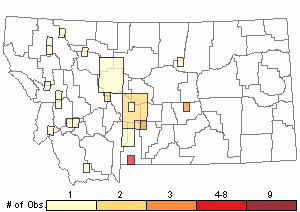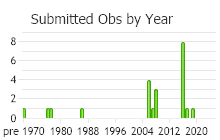View in other NatureServe Network Field Guides
NatureServe
Montana
Utah
Wyoming
Idaho
Wisconsin
British Columbia
South Carolina
Yukon
California
New York
A Dry Rock Moss - Grimmia anodon
Other Names:
A Black Rock Moss
General Description
Plants: Small cushions. Dark green to brown. Stems 0.5-1.0 cm tall.
Leaves: Oblong-ovate to oblong-lanceolate, 0.9-2.0 x 0.4-0.8 mm, concave, and keeled. Awn 0.1-1.2 mm long. Both margins plane. Costa reaches apex.
Leaf Cells: Basal laminal cells near costa and near margin are quadrate to long-rectangular, straight, thin-walled. Median laminal cells are quadrate, sinuose, and thick-walled. X-S: distal laminal cells are 1-layered with patches of 2-layers; distal marginal cells are 2-layered.
Diagnostic Characteristics
Without capsules it is harder to identify. It can be confused with G. plagiopodia and Schistidium flaccidum. G. plagiopodia generally inhabits meadow-like sites and at lower elevations compared to G. anodon. G. plagiopodia’s sigmoid seta topped by a peristomatic capsule with perforated full teeth helps in its recognition. G. anodon lacks a peristome and has an annulus. The leaves of G. plagiopoda are 2-stratose and more concave then G. anodon’s mostly 1-stratose, more keeled leaves. The leaf margins of Schistidium flaccidum are revolute toward the apex (FNA 2007).
Range Comments
Greenland; Canada: AB, BC, NB, NT, NU, ON, QC, SK, YT; United States: AK, AZ, CA, CO, ID, MI, MT, NV, NM, NY, ND, OR, SD, UT, WA, WY; ne Mexico; South America (Bolivia, Chile); Eurasia; Africa (Morocco) (FNA 2007). In Montana, known from Clark, Meagher, Missoula, Park, Ravalli, Rosebud, and Sweet Grass Counties (Elliott 2016).
Observations in Montana Natural Heritage Program Database
Number of Observations: 37
(Click on the following maps and charts to see full sized version)
Map Help and Descriptions
Relative Density

Recency



 (Observations spanning multiple months or years are excluded from time charts)
(Observations spanning multiple months or years are excluded from time charts)
Habitat
Exposed calcareous sandstone, limestone, and concrete. Low to high elevations (65 – 8900 feet). Higher latitude sites are strongly correlated with glacial refugia.
Reproductive Characteristics
Seta is 0.2-0.3 mm tall, curved, and asymmetrically attached to capsule base. Capsules are often found, lack teeth, immersed, smooth, and swollen on base. Base of capsule with 3-4, large stomata. Autoicous.
Gemmae absent on leaves.
Stewardship Responsibility
References
- Literature Cited AboveLegend:
 View Online Publication
View Online Publication Elliott, J.C. and A.K. Pipp. 2018. A Checklist of Montana Mosses (1880-2018). Updated 3 January, 2020. Montana Natural Heritage Program, Helena, Montana. 73 pp.
Elliott, J.C. and A.K. Pipp. 2018. A Checklist of Montana Mosses (1880-2018). Updated 3 January, 2020. Montana Natural Heritage Program, Helena, Montana. 73 pp. Flora of North America Editorial Committee, eds. 2007. Flora of North America North of Mexico. Volume 27. Bryophytes: Mosses, Part 1. Oxford University Press, Inc., NY. xxi + 713 pp.
Flora of North America Editorial Committee, eds. 2007. Flora of North America North of Mexico. Volume 27. Bryophytes: Mosses, Part 1. Oxford University Press, Inc., NY. xxi + 713 pp.
- Additional ReferencesLegend:
 View Online Publication
View Online Publication
Do you know of a citation we're missing? Elliot, J. C. 1993. Second checklist of Montana mosses. Unpublished report. U.S. Forest Service, Region 1. Missoula, MT. 45 pp.
Elliot, J. C. 1993. Second checklist of Montana mosses. Unpublished report. U.S. Forest Service, Region 1. Missoula, MT. 45 pp. Lawton, E. 1971. Keys for the Identification of the Mosses on the Pacific Northwest. Reprinted from 'Moss Flora of the Pacific Northwest'. Published as Supplement No. 2 of the Journal of the Hattori Botanical Laboratory. Nichinan, Miyazaki, Japan. 66 pp.
Lawton, E. 1971. Keys for the Identification of the Mosses on the Pacific Northwest. Reprinted from 'Moss Flora of the Pacific Northwest'. Published as Supplement No. 2 of the Journal of the Hattori Botanical Laboratory. Nichinan, Miyazaki, Japan. 66 pp. Lawton, E. 1971. Moss Flora of the Pacific Northwest. Hattori Botanical Laboratory. Japan: Yamabuki-cho, Shinjuku-ku, Tokyo. 362 pages plus appendices.
Lawton, E. 1971. Moss Flora of the Pacific Northwest. Hattori Botanical Laboratory. Japan: Yamabuki-cho, Shinjuku-ku, Tokyo. 362 pages plus appendices.
- Web Search Engines for Articles on "A Dry Rock Moss"





